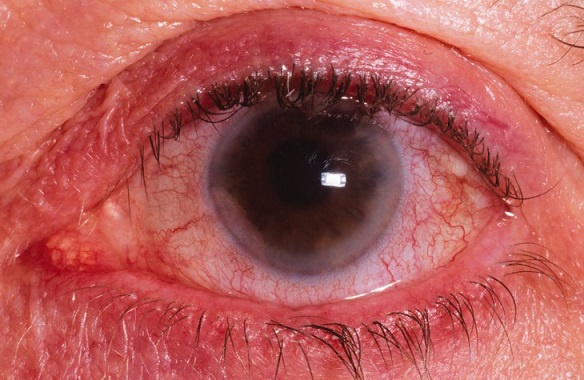Nikhil Prasad Fact checked by:Thailand Medical News Team Dec 24, 2024 3 months, 3 weeks, 6 days, 57 minutes ago
Medical News: A recent study involving researchers from institutions across China, including the Eye Hospital of Wenzhou Medical University and the Department of Ophthalmology at the Fourth Affiliated Hospital of China Medical University, has unveiled a concerning link between daily activities following COVID-19 infection and an increase in acute angle closure (AAC) cases. This condition, a severe form of glaucoma, can lead to irreversible blindness if not treated promptly. The findings provide fresh insights into how lifestyle changes brought about by the pandemic may inadvertently affect eye health.
 Acute Angle Closure Cases Rise After COVID-19 in China
A Worrying Surge in AAC Cases
Acute Angle Closure Cases Rise After COVID-19 in China
A Worrying Surge in AAC Cases
AAC occurs when the peripheral iris blocks the anterior chamber angle, causing a dangerous rise in intraocular pressure. Common symptoms include severe eye pain, blurred vision, headache, and nausea. The study, conducted between December 2022 and January 2023, focused on analyzing AAC cases before and after the relaxation of COVID-19 lockdown measures in China. Researchers observed that the number of AAC cases nearly tripled during the post-lockdown period, compared to corresponding months in previous years.
This
Medical News report highlights the profound effects of COVID-19 on AAC patients. Researchers collected data from 23 ophthalmic centers across 17 regions in China, analyzing cases involving over 3,200 patients. The team focused on understanding how changes in water intake, sleep quality, and use of medications during COVID-19 influenced AAC occurrences.
Daily Habits That Increase Risk
The study revealed that patients who contracted COVID-19 were more likely to report increased water consumption, poorer sleep quality, and extended use of their eyes in dark environments. These changes are believed to contribute to the sudden rise in AAC cases.
One key finding was that 37.3% of COVID-19-infected AAC patients increased their water intake significantly during their illness. In contrast, only 2.2% of non-COVID-19 AAC patients reported similar changes. Furthermore, nearly half of the COVID-19-infected AAC patients experienced worsened sleep quality compared to just 4.1% in the non-COVID-19 group.
The use of antipyretic and analgesic medications to manage COVID-19 symptoms was another factor. Approximately 58.4% of COVID-19-infected AAC patients took these medications, compared to only one patient in the non-COVID-19 group. Common drugs included paracetamol and pseudoephedrine, both of which have been linked to elevated intraocular pressure in susceptible individuals.
How COVID-19 Affects Eye Health
The relationship between COVID-19 and AAC is complex. The SARS-CoV-2 virus uses ACE2 receptors to enter cells, and these receptors are also present in the eyes. This may explain why some patients develop ocular complications during or after COVID-19. Researchers believe that stress, emotional distress, and delays in seeking medical care during the pandemic may have exacerbated the issue.
&
nbsp;
COVID-19 may also indirectly impact eye health through fever and electrolyte imbalances. Conditions like hyponatremia, which is common in COVID-19 patients, can create osmotic pressure imbalances that contribute to AAC.
Additionally, increased screen time and prolonged exposure to dark environments during lockdowns may have further stressed the eyes of vulnerable individuals.
Significant Findings from the Study
Among the 875 AAC patients studied during the post-lockdown period, 54.2% had either confirmed or suspected COVID-19. These patients showed significantly higher intraocular pressure (averaging 40.8 mmHg compared to 35.3 mmHg in non-COVID-19 patients) and worse visual acuity. Moderate to severe corneal edema was also more common in the COVID-19 group (47.5%) than in the non-COVID-19 group (37.2%).
Interestingly, the study found no significant difference in the time it took for COVID-19 and non-COVID-19 patients to seek treatment after symptoms began. This suggests that heightened awareness and improved healthcare preparedness during the pandemic might have mitigated delays in accessing care.
Broader Implications
The findings underscore the importance of monitoring lifestyle changes and medication use in AAC-prone individuals, particularly during health crises like the COVID-19 pandemic. Early detection and intervention are crucial to preventing irreversible damage.
The study also highlights the role of public awareness in promoting eye health. Many AAC patients are unaware they have narrow-angle eyes, a major risk factor for the condition. Regular eye exams and education about the early symptoms of AAC can significantly reduce the risk of blindness.
Conclusions
This comprehensive study demonstrates a clear link between COVID-19 infection, related daily activity changes, and a rise in AAC cases. The findings emphasize the need for healthcare providers to consider modifiable lifestyle factors when managing patients at risk for AAC. By addressing these factors early, clinicians can help prevent severe outcomes, including blindness.
Moreover, the study serves as a reminder of the broader impacts of global health crises on non-communicable diseases. The ripple effects of the COVID-19 pandemic on eye health provide a valuable lesson for public health preparedness in future emergencies.
The study findings were published in the peer-reviewed journal: BMC Ophthalmology.
https://link.springer.com/article/10.1186/s12886-024-03769-z
For the latest COVID-19 News, keep on logging to Thailand
Medical News.
Read Also:
https://www.thailandmedical.news/news/breaking-covid-19-news-study-claims-that-omicron-infections-can-lead-to-acute-primary-angle-closure-and-also-primary-angle-closure-glaucoma
https://www.thailandmedical.news/news/breaking-covid-19-news-chinese-study-discovers-that-sars-cov-2-increases-the-risk-for-developing-acute-angle-closure-glaucoma
https://www.thailandmedical.news/articles/glaucoma-news
